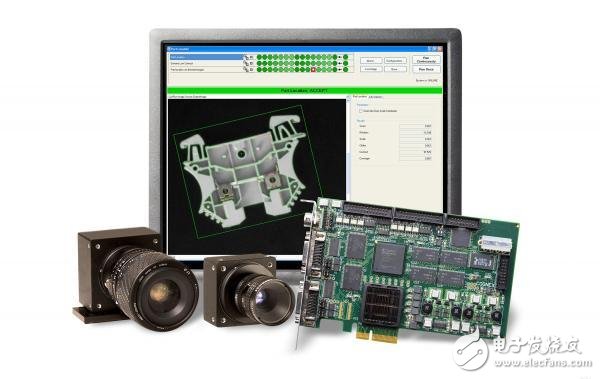Lens Selection and Optical Principles and Design of Industrial Machine Vision System Selection Factors Analysis
If you compare an industrial camera to a human eye, an industrial lens is like an eyeball. It is directly related to the distance, scope, and effect of the object. The selection of industrial lenses should consider the following points:
1) The industrial lens size should be equal to or greater than the size of the industrial camera imaging surface. For example, 1/3′′ industrial cameras can be selected from industrial lenses ranging from 1/3′′ to 1′′, but the horizontal viewing angles are the same size. Only industrial lenses larger than 1/3′′ can be used more. , more accurate industrial lens center light path, so it can improve image quality and resolution.

2) Select the appropriate industrial lens focal length. The larger the focal length, the farther the monitoring distance is, the smaller the horizontal viewing angle is, the narrower the monitoring range is; the smaller the focal length is, the closer the monitoring distance is, the larger the horizontal viewing angle is, and the wider the monitoring range is. The industrial lens focal length can be estimated by the following formula.
f=A&TImes;L/H
(f--lens focal length; A--camera CCD vertical size; L--subject to lens distance; H--subject height)
Format 1 inch 2/3 inch 1/2 inch 1/3 inch 1/4 inch
CCD vertical size 9.6mm 6.6mm 4.8mm 3.6mm 2.7mm
3) Considering the change of ambient light, light plays an important role in the image collection effect. Generally speaking, for an environment where the light changes are not obvious, a manual iris lens is often used, and the aperture can be adjusted to an ideal value without moving; if the light changes greatly, such as outdoor 24-hour monitoring, automatic selection should be used. The aperture can automatically adjust the aperture value according to the light and dark changes of the light to ensure the image quality. However, it should be noted that if the illumination of the light is not uniform, especially when the contrast between the monitoring target and the background light is large, the effect of using the auto iris lens is not satisfactory.
4) Consider the best monitoring range. Because the industrial lens focal length is inversely proportional to the horizontal viewing angle, it is impossible to see both at the same time and to see wide and clear. Each focal length lens can only achieve the best monitoring effect within a certain range, so if the monitoring distance is long and the range is large, it is best to increase the number of cameras, or use a power zoom lens to install with the pan/tilt. .
5) The industrial lens interface should be consistent with the industrial camera interface. Today's industrial cameras and industrial lenses are usually CS-type interfaces. CS-type cameras can be mated with CS and C-type lenses. However, when mated with C-type lenses, it is necessary to add a matching ring between industrial lenses and industrial cameras. Otherwise, the protective glass of the CCD imaging surface may be damaged, causing damage to the CCD industrial camera. C-type industrial cameras cannot be mated with CS-type industrial lenses.
In recent years, the use of image measurement of item size has become a trend in the industry. Advances in equipment such as cameras, imaging software, and lighting components have made the accuracy of image-measuring items comparable or better than manual or laser measurements.
Integrating the application of optical system engineering, we can find out the quality of the optical product determines the quality of the system, and the telecentric lens can perform various forms of optical measurement.
Software engineering requires images with high resolution, high contrast and low geometric distortion to determine accurate measurement data.
In addition to the requirements of the optical device itself, the choice of viewing angle is also of considerable importance. Measuring objects under inappropriate observation points can cause distortion of the image captured by the object.
In addition to the interference caused during image processing, system designers also consider several limitations of the optical equipment itself that affect the accuracy of optical measurements:
1. Abnormal magnification due to the placement of objects
2. Image deformation
3. Error caused by angle of view selection
4. Low image resolution
5. Uncertainty of boundary caused by inappropriate light source interference
Telecentric lenses can effectively reduce or even eliminate the above problems, so telecentric lenses have become a decisive factor in precision optical measurement systems.
Figure 1: Optical principle of different lenses
Next, we briefly introduce how the telecentric lens effectively reduces noise and distortion.
First, the consistency of magnificationOptical metrology systems typically take pictures directly above the object (without recording the side of the object) to measure their diameter or linear distance. Because many mechanical components cannot be accurately positioned or have height differences or thickness problems, engineers need a reliable optical measurement system to determine the actual distance between the image and the object.

The upper left picture shows the rack on the cylindrical part with a telecentric lens; the lower left picture shows the image of the same object with a normal lens; the upper right picture shows the image of two identical objects taken with a telecentric lens at a distance of 100 mm; right The image below shows an image captured with a normal lens in the same situation.
This Automation curtain is specially designed for automation industry. SDKELI LSC2 light curtain is designed for automation field, with small size, compact structure and strong anti-interference ability, and the product meets IEC 61496-2 standards. The automatic light curtain is with reliable quality and very competitive price. It has been used in many factories and has replaced curtains from Sick, Omron, Banner, Keyence, etc.
Automatic Light Curtain,Laser Light Curtain,Automation Light Beam Sensor,Automatic Infrared Beam Sensor,Infrared Beam Curttain Sensor,Infrared Beam Sensor
Jining KeLi Photoelectronic Industrial Co.,Ltd , https://www.sdkelien.com